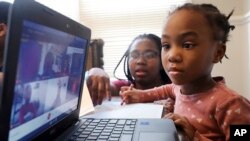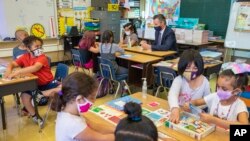For kindergarten through 12th grade schools in America, this month marks the end of the academic year — the third since the start of the coronavirus pandemic. Most schools returned to in-person education after several semesters of virtual instruction, but teachers like Peter Ballantoni are concerned successive, abnormal years have caused students to fall further behind.
“The student failure rate at the beginning of this year was atrocious,” said Ballantoni, a high school music teacher in Patterson, New York. “Forty percent of our students were failing two or more classes, and that’s with us padding their grades.”
Rather than focusing entirely on helping students catch up on missed content, however, Ballantoni and other teachers have also had to tend to the emotional needs of students struggling after a protracted period of pandemic-induced isolation.
“We’ve had to kind of tip-toe around the learning issues just to make sure the kids are okay,” he explained. “Our school had more fights, more estrangement issues, and more kids hiding in weird places — trying to eat lunch alone in stairwells, corners, and bathrooms. We had to deal with that first. It’s basically a third ruined school year because of COVID.”
Measuring the effects of the pandemic on students is challenging at this early stage.
But researchers and teachers agree nearly all students were impacted in some way, even though each state and school navigated balancing safety and learning differently.
The Center for Education Policy Research at Harvard University estimated that one-fifth of American students were enrolled in districts that continued virtual learning for the majority of the 2020-21 school year. Those students, they say, lost the equivalent of as much as 22 weeks of learning.
“I don’t know about the empirical evidence,” said Bill Kloppenburg, a high school teacher in Boise, Idaho, “but I can see students right in front of my eyes. They’ve basically lost a year of school.”
Falling behind
In spring of 2020 (the 2019-20 school year), which coincided with the start of the coronavirus pandemic’s arrival in the U.S., nearly all American schools turned to remote learning.
The results were devastating. Remote education was new to most Americans and schools struggled to overcome the technological hurdles of constructing virtual classrooms on the fly.
“The hardest thing was to even know if students were paying attention, because they weren’t required to have their camera on,” said Charlotte, North Carolina high school math teacher Adam Melchin. “We weren’t allowed to fail them, even if they didn’t turn in assignments, and when students realized that, they completely stopped doing the work.”
Two years later, Melchin said he’s still struggling to help students catch up to where they should be at this stage of their educational development.
“They missed so many of the basic, foundational skills they need for my class,” he explained, “so I can’t even move into my curriculum until they get that previous knowledge.”
Parents are understandably worried about the academic implications of the learning gap. However, many — including Rebecca Urrutia, a mother of four children in Tolland, Connecticut — are equally troubled by the pandemic’s social and emotional toll.
“It was soul-sucking for my kids to be ‘at school’ on their computers for six hours each day,” she said. “Even when they returned to in-person learning, the kids weren’t allowed to socialize. The school would play movies during lunch and keep them masked and distanced.”
Research released jointly by Lurie Children’s Hospital and the University of Chicago showed that 80% of parents said their children have spent significantly less in-person time with friends, while 63% of parents said their children spend more time alone and on screens for non-educational purposes.
It shouldn’t be surprising, then, that more than a third of children in the study were described by parents as lonely, while nearly 25% were described as anxious, stressed, agitated, and angry.
The U.S. Centers for Disease Control reported that in 2020, the first year of the pandemic, mental health-related emergency room visits increased 31% for adolescents aged 12-17 compared to 2019. Suspected suicide attempts also rose in that age group, especially among female adolescents, as the pandemic took hold.
“It stunted the social and emotional development of so many kids,” Urrutia said. “We have this whole generation of kids who need to relearn how to be functioning humans –how to communicate with people in person again.”
Closing the gap
While American students across the board have been affected by the pandemic, low-income students have been hit hardest.
Data from Harvard’s Center for Education Policy Research showed that the education gap between students of differing income levels has increased over the last three school years. For students who went to schools that continued virtual learning for the majority of last year, for example, more affluent schools lost the equivalent of 13 weeks of in-person instruction, while less affluent schools lost the equivalent of 22 weeks.
Race-based educational gaps have widened during the pandemic, as well. A recent study found that elementary school achievement in reading and math declined more for Hispanic and Black students than their white and Asian American peers.
Educators say parental involvement has been especially important in remote learning.
“If the child had family members who could supervise them during the lockdown and make sure they were doing their assignments, they don’t seem to have fallen behind as much,” explained Kloppenburg of Idaho. “The kids that didn’t have as much in-person accountability, because maybe their parents weren’t in the house — they had jobs where they had to go somewhere — those students are further behind.”
Districts, schools, and teachers are now tasked with figuring out how to make up for lost time.
That is part of Assistant Principal Adam Kohler’s job at his New Orleans middle school.
“I don’t think people realize how hard our educators are working for our students and families,” he said, “both over the last two years, and still today as we try to reverse these learning losses.”
Kohler said his school is providing tutoring for students within and outside school hours, has created personalized online learning resources that can be used during and after the school day, and is even preparing an extended “summer experience” to close the gap experienced by his students, many of whom are African American.
Experts warn reversing academic losses won’t be easy, however.
“Our schools have faced so many obstacles in the last few years,” said Alex Jarrell, chief innovation officer at New Schools for New Orleans, a nonprofit organization that supports the city’s schools.
“During this pandemic, our students faced trauma and loss all around them,” Jarrell said. “Families have struggled with food security and access to housing. All of this made it difficult for children to focus on schoolwork. Our teachers and school leaders are working hard to overcome this, but these are impacts we’ll be addressing for years.”



